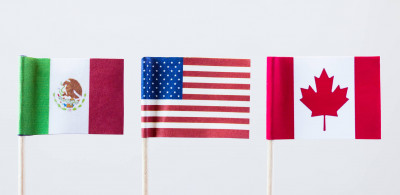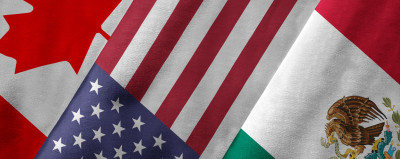On December 10, 2019, Canada, the United States and Mexico agreed to update certain elements of the new North American Free Trade Agreement (NAFTA) in order to improve the outcome and pave the way for the ratification and implementation of the Canada-United States-Mexico Agreement (CUSMA) in the three countries. At an event at the National Palace of Mexico, the agreement to amend the protocol to finalize CUSMA (which will replace the North American Free Trade Agreement or NAFTA) was signed in the presence of the representatives of the three governments.
Although CUSMA was signed in November 2018, the Democrats in the U.S. Congress wanted changes to be made before implementing it. The actual text with the new amendments has not yet been made public. However, the Summary of revised outcomes is published by the Government of Canada as well as by the “Ways & Means” committee of the U.S. House of Representatives.
Amendments will need to be ratified by the Mexican Senate (which had previously ratified CUSMA signed in November 2018); this new agreement also needs to be approved by the Parliament of Canada and both U.S. Chambers (Congress and Senate) before coming into force.
There is a lot of speculation about the process and timeline for ratification in the United States, as a result of the current political climate between the White House, Democratic Congress and Republican Senate, not to mention the impeachment proceedings of the U.S. President currently underway, which may affect the U.S. timetable.
On December 16, President Trump provided the Senate Finance Committee with the legislative text needed to implement CUSMA. The Ways & Means Committee of the House of Representatives was scheduled to review the bill on December 17, with full review and passage by the House scheduled for December 19. Although the House should pass the bill before the Christmas break, Senate majority leader Mitch McConnell announced that the Senate would not pass the bill until the Senate resumes session in January 2020 and only after other pending cases on hold have been dealt with. In the House, the bill for CUSMA has been assigned the number H.R. 5430.
Although the new Liberal minority government has some obstacles to overcome, ratification here in Canada should happen without much dispute. That said, and without prejudice, everything seems to be heading toward the new CUSMA coming into effect at the end of the first quarter of 2020 or in the second quarter.
HOW TO PREPARE FOR THE NEW CUSMA?
Annual certificates of origin - NAFTA
The NAFTA agreement is still in effect. Consequently, you should still proceed with the renewal of your 2020 blanket NAFTA certificates of origin. Most blanket certificates of origin expire on December 31st and are renewed and registered with your customs brokers between November and January of each year. Ensure that you can continue to benefit from the NAFTA preferential origin treatment for eligible originating products in the early months of 2020 until CUSMA comes into force.
Record keeping and records
All importers and exporters must maintain their certifications of origin, with supporting proof for five years plus the current year. Even after the new CUSMA comes into effect, you will need to keep your old NAFTA certificates of origin and relevant proof for six years after their use. These record keeping obligations will not change under the new agreement.
Audits from Customs authorities concerning origin
Customs agencies will continue to audit importers, exporters and producers to ensure the validity of their certifications of origin and the importer’s eligibility for preferential treatment, whether it’s under the new CUSMA or under NAFTA.
If CUSMA comes into effect in 2020, the Canada Border Services Agency (CBSA) and U.S. Customs & Border Protection (CBP) can audit old NAFTA certifications of origin retroactively for up to four or five years, respectively (e.g. going back to 2016 and 2015).
To date, almost 25 years after NAFTA’s signing, several North American exporters continue to certify their products as NAFTA “originating” products on an intuitive basis, without having analyzed the country of origin in accordance with the agreement’s specific rules of origin; although this exercise is prescribed before certifying a product on a certificate of origin, this analysis is often neglected. Several businesses are caught off-guard when Customs instigate a country of origin audit and they must prepare a response with all the documentary proof requested by the auditor, usually within a very short period (e.g. 30 days or less).
Often, as part of such audits, the product certified as NAFTA “originating” does not qualify under the rules of origin of the agreement and is disqualified from preferential origin treatment, for the audited transaction as well as for any other transaction where the invalidated certificate was applied.
It is worth mentioning that when Customs invalidates an exporter’s certificate of origin, it will be the importer who benefited from the preferential origin treatment at the time of the importation who will bear the costs (e.g. retroactive assessment of duties and taxes, interest fees and possibly penalties based on the level of negligence uncovered in the audit).
Rules of Origin – Do your products really qualify for preferential treatment?
For businesses that have the practice of conducting a detailed analysis of the country of origin before certifying their product on a certificate of origin, take note that the specific rules of origin for certain products will change under the new CUSMA agreement. Rules of origin are based on the tariff classification (HS Code) of the product being certified. Among other things, the following sectors are the most affected by the changes to the rules of origin (NAFTA vs. CUSMA):
- Motor vehicles
- Agricultural products
- Dairy products
- Chemicals
- Textile products
- As well as other products
Either the differences imply a change to the tariff shift rules by adding or subtracting from the rule certain components/inputs that are not subject to the prescribed tariff shift; or the rule change implies an increase or decrease in the percentage of regional value content (RVC), i.e. North American content (CA, U.S. or MX), when an RVC calculation is required.
Another important change is the increase in the “de minimis” threshold for non-originating content. Under NAFTA, the “de minimis” threshold was 7%; CUSMA allows 10%. (% of product components that do not undergo a tariff shift).
All of this means that CUSMA could have an impact on manufacturers and supply chains in a wide range of industries. Some products, previously duty-free under NAFTA, may no longer be eligible for preferential origin treatment under the new agreement. Similarly, certain goods that were not eligible under NAFTA could become eligible once CUSMA comes into effect.
Each product, previously certified as “originating” under NAFTA or previously disqualified, should be subjected to a new origin analysis under the new CUSMA’S rules of origin.
NAFTA rules of origin – General provisions
NAFTA rules of origin – Specifics of HS Codes
Note: CUSMA’s rules are subject to change in the final text following the most recent negotiations between the three countries.
Certification of origin
CUSMA streamlines the certification of origin process previously used under NAFTA. These changes are intended to expedite the customs clearance of goods by reducing strict requirements, such as original signatures and prescribed formats for certificates, while providing greater flexibility to importers and exporters.
The changes made modernize business practices and reflect a desire to reduce administrative costs associated with complying with requirements that generally do not involve high levels of non-compliance. There are three significant changes with respect to filing certifications of origin under CUSMA:
- no prescribed format is required, unlike with NAFTA, which requires the use of a certificate of origin on a specific form recognized by Customs agencies;
- electronic signatures and filings are allowed; and
- importers can certify the origin, unlike with NAFTA where only producers and/or exporters can complete a certificate of origin.
Under NAFTA, the parties had to use a prescribed form for the certificate of origin, which the exporter had to fill out. Under CUSMA, the parties do not need to complete a prescribed form. Certification may be provided on an invoice or another document, but must, in addition to other requirements, specify that the goods originate (meeting the prescribed requirements of Chapter 5 of CUSMA) and describe the goods in sufficient detail to enable its identification.
In Canada and the U.S., the CUSMA certification of origin can be signed by an exporter, producer or importer and can be completed and submitted electronically with a digital signature. Mexico will have up to three years after CUSMA goes into effect to allow importers to complete a certification of origin.
Once CUSMA goes into effect, the former NAFTA Certificate of Origin form will be obsolete and ineligible to certify “originating” products. The old certificate will only be used for NAFTA certified goods that were imported prior to the effective date of the new CUSMA. For products imported after the implementation of CUSMA, you will need to use the certification of origin with the information prescribed in the new agreement.
In due time, W2C will provide you with an example of the new CUSMA certification on its website.
Other references:
CUSMA Information Page – Government of Canada
Full CUSMA text (current version)
Full NAFTA text (currently in effect)
In conclusion, although the new CUSMA agreement is based on NAFTA’s existing principles, there are still several changes; some changes are nuanced while others are more drastic. It is recommended that you review the management of your certifications, country of origin analyses as well as sourcing of materials and components in light of the new CUSMA rules. Nevertheless, NAFTA’s rules and procedures remain in effect until the effective date of CUSMA.
W2C offers several services to help you navigate the changes ahead, such as:
- customs training
- determining tariff classifications
- origin analyses based on any FTA (NAFTA, CUSMA, CETA, CPTPP, etc.)
- support during audits
- requests for advance rulings on origin
- and even more
Contact W2C today to speak to one of our consultants.



